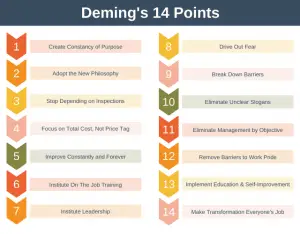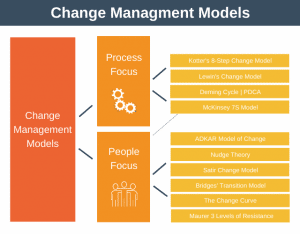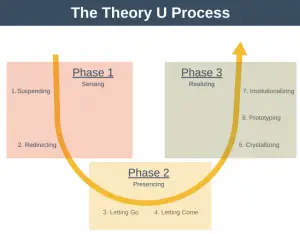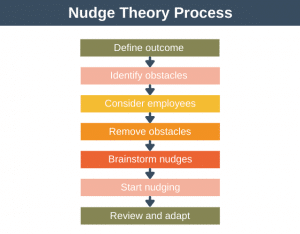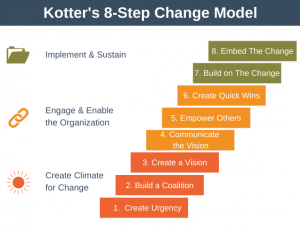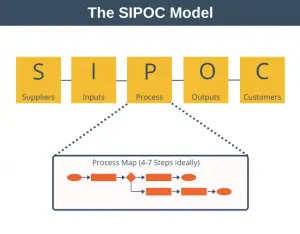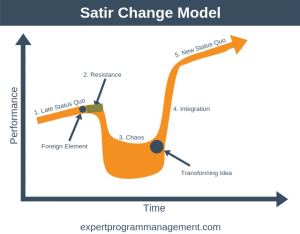Unfreeze, Change, Refreeze, also know as Kurt Lewin’s Change Management model or Lewin’s 3 Step model, is a method for managing change within an organization.
To stay competitive, organizations need to change continuously. Without change, an organization will stagnate, be surpassed by its competition, become irrelevant, and may eventually go out of business.
Change is not just important but critical to every organization.
Unfreeze, Change, Freeze
Kurt Lewin (1890 – 1947), a German-American psychologist, is widely considered a founding pioneer of change management.
Side Note
Before we jump in and examine the Unfreeze, Change, Refreeze model in detail, it is worth noting that there is evidence that Lewin never developed the 3-Step model and that it only came into being after his death.
Lewin’s Change model involves three steps: preparing for change, making the change, and finally, normalizing the change and associated new ways of working.
The Unfreeze, Change, Refreeze model terminology comes from the idea of an ice cube that you want to transform into a different shape, such as a cone.
What is the best way to transform a cube of ice into a cone of ice? You can, of course, smash up the cube and form the fragments into a cone, but the easiest way is probably to melt the cube (unfreeze), place the liquid water into a cone-shaped mold (change), and then freeze the ice again to form a solid cone (refreeze).

Another way to say this is that Unfreeze, Change, Refreeze involves creating the desire to want to unfreeze the current status quo, implement the necessary changes, and then solidifying the new ways of working as the new normal.
Let’s examine the model in a little more detail.
Unfreeze
The first stage of the 3-Step model is about preparing to make the change. This means preparing ourselves and others within the organization for the change to come.
In this stage, you want to ensure that everyone understands why the change is necessary and why the change needs to happen urgently. Change can be required for many reasons, including, in response to competitors, in response to new legal requirements, to save costs, and to boost profit or revenue.
In this stage, you also want to ensure that everyone understands what the organization will look like once the change has been successfully made. Again, this can comprise many parts, including how the organization structure will change, what new ways of working will be in place, and how old ways of working will be adjusted.
Unfreezing involves ensuring that everyone has a greater desire to change than they do for things to stay the same. This transition won’t happen overnight; it will take time to get everyone on the same page. However, taking the time to get everyone on the same page and committed to the change makes it much more likely that the change will be a success.
Force Field Analysis
One way to understand if a team or organization is motivated to change is to use another model developed by Kurt Lewin called Force Field Analysis.
Using the terminology of this model, we can analyze a situation to see that if the forces (factors) in favor of change outweigh the forces against change, then the team will be motivated to change. The team will want to change rather than resist the change.
Change
The second stage of Lewin’s 3-Step Model, Change, should happen once the first stage is complete and your entire team or organization understands why the change is necessary and is committed to making it happen.
This stage isn’t a single step but a process whereby you transition towards the new way of working. In this stage, your team is unfrozen and moving towards a new way of doing things.
For a simple change, this step could happen in a matter of days, but for a more complex change, it could take months or even years.
During the Change phase, it is important to continually remind your team why the change is happening and how it will benefit them once completed.
Unfortunately, with most large-scale organizational changes, some individuals will not benefit from the change. You need to foresee and delicately manage these situations. The change curve can be a valuable tool in these situations.
Refreeze
You enter this phase once all changes have been made and people are beginning to embrace the new status quo. In this stage, you Refreeze the organization so that the new ways of working become the new normal.
This phase helps the organization to institutionalize any changes that have been made. People become comfortable with their new roles, new interactions, and new processes.
Ultimately, the purpose of this stage is to ensure that employees are confident and comfortable with their new ways of working.
Finally, after your team or organization has worked hard to transition to a new way of working, it is a good idea to take some time to celebrate their success. This gives the team a moment to reflect upon and feel proud of what they have achieved.
How to Use Unfreeze, Change, Refreeze
With just three steps, the model can seem an overly simplistic tool to use when you’re thinking about embarking on large-scale organizational change.
This raises the question of how to use Unfreeze, Change, Refreeze in practice? One way to elaborate the model is to map it to Kotter’s Change Management model to see the key steps that need to be taken during each phase.
This combining of models isn’t mandatory but can help provide you with concrete actions within each phase of the 3-Step model.

In this diagram, you can see the Lewin’s Unfreeze, Change, Refreeze model defines the phases of the change initiative, and Kotter’s Model describes the steps within each phase.
As you can see, the Unfreeze phase corresponds to the steps:
1. Create urgency: craft a compelling narrative as to why the change has to happen urgently.
2. Build a coalition: Get senior people and other key people on board and bought into the initiative.
3. Create a vision: Paint a compelling picture of how things will be different once the change has been successful.
4. Communicate the vision: Communicate broadly and frequently to ensure everyone understands why the change is essential.
The Change phase corresponds to the following steps:
5. Empower others: Give others the time and authority to make the change happen.
6. Create quick wins: Schedule quick wins early in the plan to create momentum and build a shared sense of positive progress.
7. Build on the change: Real change takes a long time. Repeat steps four to six over and over until the change is successfully completed.
Finally, the Refreeze phase corresponds to:
8. Embed the change: Institutionalize the change by embedding it into the daily work of everyone in the organization.
As already mentioned, it isn’t mandatory to combine the two models, but it can help you understand in more detail what needs to happen in each step of Lewin’s 3-Step model.
Taking a step back from the detail, the real power of the 3-Step model is that by containing just three phases, it forces you to focus on the three fundamental things you must do to lead successful change.
Advantages and Disadvantages
There are several advantages and disadvantages associated with Lewin’s Unfreeze, Change, Freeze model.
Advantages
- The 3-Step model is intuitive and easy to understand.
- Before beginning any change, the model forces you to take the time to prepare and motivate your team to want to change. Having a team motivated and committed to the change increases the odds that the change will be successful.
- Because Unfreeze, Change, Refreeze is so simple, with just three steps, it forces you to consider the fundamentals of what’s important (the 3-steps) when managing complex change.
Disadvantages
- Organizational change is complex, yet Lewin’s Change Management model has just three steps. For this reason, the model is often considered overly simplistic.
- Today, modern organizations are continuously improving, making it difficult to take the necessary time to pause and perform the refreeze step.
Summary
Kurt Lewin’s 3-Step model is an intuitive and easy-to-understand model for managing complex organizational change.
Because the model has just three steps, it is often combined with Kotter’s Change Management Model to make it easier to implement in practice.
The strength of Unfreeze, Change, Refreeze is that with just three steps, it forces you to focus on the fundamentals necessary to create successful organizational change: preparing for the change, implementing the change, and institutionalizing the change.
